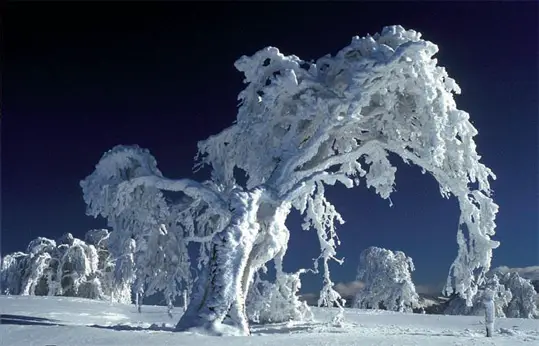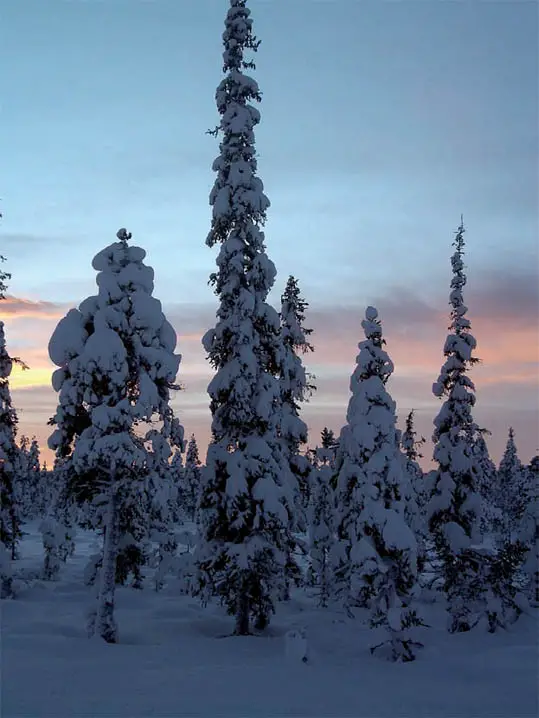Ecology of Snow
The importance of the ecology of snow has been recognized by science since at least the beginning of the 20th century. However, even today many observations remain anecdotal. In the 1950s, Gjaerevoll analysed the way in which the alpine plant community structure was shaped by snow. Within the past decade, snow manipulation experiments have explored the effects of snow depth and snow-cover duration on plant communities and ecosystem processes. Recently, models of snow cover have been applied to ecological problems.
The ecology of snow plays a dual role in terms of temperature regulation. The high albedo of snow cover reduces net radiation, and snow also acts as a heat sink, removing energy from the atmosphere in the form of heat. This means that the presence of snow cover inhibits soil warming until the snow melts, preventing biological activity that requires temperatures above 0oC. However, snow is an efficient insulator, keeping soil temperatures near Zero 0C and reducing the extremes of temperature experienced by vegetation and soil in the zone under the snow (subnivean cavity). In autumn, the insulation effect of snow on unfrozen ground can even result in fungal decay of the vegetation, which can kill reindeer calves when they eat the vegetation. The subnivean environment is also very humid. Under thin snow packs in spring, light levels permit limited photosynthesis for lichens and evergreen tundra shrubs. This is an important adaptation given the short growing season. Plants in the “greenhouse of snow” created by the subnivean cavity can start to grow weeks before neighbouring plants covered by deep snow.
The ecology of snow includes the forces on the objects that it covers. For example, snow in southern Finland at the end of March, estimated to weigh 100–120 kg per m2, compresses the shoots of bog moss. The weight of snow can deform and break trees, branches and the soft tissues of plants such as grasses and forbs. Snow can facilitate the spread of some woody plants by pressing branches to the ground surface – the branches then develop roots and form new individuals. Snow pressing directly onto vegetation protects it, to some extent, from grazing.
Plants that are covered by the snow are also protected from drying out in the winter and from erosion of tissues by ice crystals. For this reason, the height of vegetation is often uniform and correlated with snow depth.

The ecology of snow has many effects on vegetation, including the ability to deform and break trees with its weight like on these Beech trees above. Photo: Fillies Wo/UNEP/Still Pictures
Snow also supports weight, including the various ground pressures that passing animals exert. While snow can support small animals such as birds, small mammals, hares and foxes with only minor deformation, larger mammals such as reindeer and moose experience a critical snow depth above which they cannot move. The ecology of snow can, therefore, enhance access across the landscape for animals by smoothing the terrain or forming bridges across gullies, or it can inhibit access by being too deep or too soft. The solid matrix of snow can be shaped and made into dens for polar bears. The consistency of snow also allows the formation of a subnivean cavity in which small mammals nest and feed, protected from predators such as foxes and snowy owls. Along streams in late winter, the subnivean cavity can be as wide as 2 m.
The ecology of snow includes the provision of a habitat for some “primitive” forms of life. A relatively abundant and diverse array of micro-organisms can be found on both seasonal snow cover and persistent snow on glaciers. These organisms include algae that can colour the snow red, blue or green, bacteria, fungi, diatoms, viruses, rotifers and tardigrades.
On Signy Island, a small subantarctic island, cell numbers range from 5000 cells per cubic millimetre for coloured snow to 1 to 2 cells per cubic millimetre for clean snow. The presence of organic matter in and on snow reduces albedo and results in local melt and accumulation of nutrients. The fractional snow cover (snow in patches) in the spring months affects the breeding of certain ground nesting species, such as waders, ducks and geese. Fractional snow cover, particularly associated with small-scale topographical differences within the landscape, also affects the distribution of plant communities and species. Plant communities that are characteristic of depressions where snow accumulates have short growing seasons and are waterlogged after thaw39 whereas communities on wind-exposed ridges are more drought tolerant. Traditional Saami knowledge has described the influence of snow cover on the vertical distributions of lichens that live on mountain birch stems in the subarctic;Parmelia olivacea grows above the winter snow line, whereas Parmeliopsis Ambigua grows below the snow line and is covered by snow for six months per year.

Trees with a narrow canopy like the Spruce trees, collect less snow and are less likely to suffer damage. Photo: Terry Callaghan
Snow accumulates debris and chemicals including plant nutrients and pollutants from the atmosphere. Some of these, such as atmospheric nitrogen and seeds, accumulate over the winter and are then released or re-distributed over the landscape. Snow melt provides an important source of nitrogen for tundra ecosystems and can result in a flush of moss growth in spring. However, the accumulation of chemicals by snow can have negative effects on vegetation. Although accumulations of nitrate can be potentially assimilated by mosses and related plants under the snow pack, at high concentrations characteristic of areas south of the Arctic, both nitrate and sulphate can cause physiological damage to plants under the snow.
Just as snow has numerous effects on vegetation, vegetation in turn exerts major effects the ecology of snow. Wind can remove up to 70 per cent of the snow cover in alpine areas, as well as in Polar Regions and on the prairies. Trees and tall shrubs reduce wind speeds and thereby affect the distribution of snow on the ground.
The forest canopy can trap snow, especially in mountain regions with coniferous vegetation, resulting in increased snow depth underneath the vegetation. Depending on the canopy characteristics of the vegetation, the opposite scenario can also occur. In dense coniferous forests, up to 60 per cent of snow fall can be intercepted by the canopy and stored on the branches of the trees. This results in a decrease in snow depth underneath the vegetation, as much of the snow changes to gas (sublimates) or blows away before it falls to the ground.
Snow that reaches the ground has been “filtered” by the canopy and is less dense than that in open areas. Vegetation also affects the amount of snow precipitation and the rate of snow melt. Trees and shrubs affect surface albedo – for example, black spruce can intercept up to 95 per cent of incoming radiation. Trees and shrubs thus increase local temperatures that affect snow fall, thereby indirectly moderating the amount of snow precipitation. The presence of a forest canopy generally slows the rate of snow melt (up to three fold) because it reduces net radiation and wind speeds, while a shrub canopy slightly increases the rate of snow melt. Snow within shrub canopies is deeper and less dense, which reduces heat transfer through the snow pack and increases winter soil temperatures by 2 ºC relative to adjacent shrub-free tundra. In spring when the snow starts to melt, the contrasting albedos of the vegetation and the snow enable the vegetation to transfer heat to the ground, resulting in local melt which creates holes in the snow around vegetation.
All Material for this page on Ecology of Snow is sourced from: United Nations Environment Programme (UNEP), 2007, Global Outlook for Ice and Snow, http://www.unep.org/geo/geo_ice/
